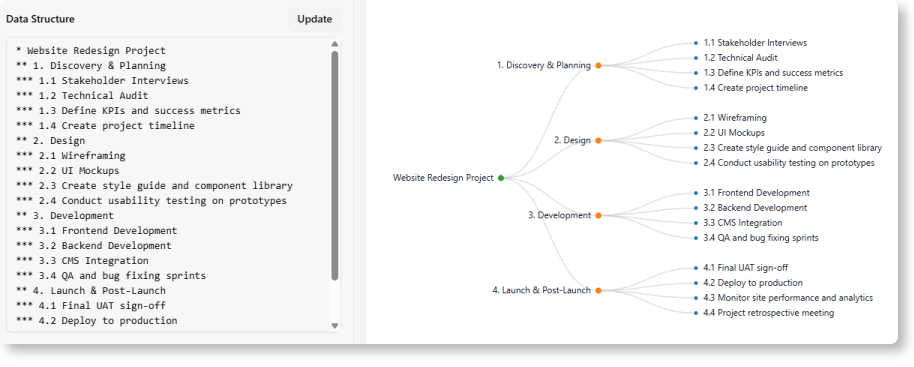Introduction
Projects fail for many reasons, but the most common cause is a simple one: the team does not share the same understanding of what must be done. A Work Breakdown Structure (WBS) solves this problem by converting a project into a clear, structured hierarchy of phases, tasks, and deliverables.
With AI-assisted tools like the Visual Paradigm Online Tree Diagram Maker, creating a WBS is no longer a time-consuming activity. The entire structure can be generated from a short prompt, refined through text-based edits, and enriched with properties like deadlines, assignees, and status. The result is a diagram that brings clarity and accountability to every part of your project.

1. WBS Makes Your Scope Clear—and Prevents Misunderstandings
A well-built WBS creates a “shared language” for the project. Instead of a long, flat task list, you have a visual hierarchy that shows:
-
What the project includes
-
How major phases break into smaller components
-
What the final deliverables should look like
This structured view removes ambiguity. For example, instead of a vague item like “Prepare Website,” the WBS breaks it into concrete elements:
-
Content planning
-
Visual design
-
Frontend development
-
Backend integration
-
Testing and review
Now everyone knows what “Prepare Website” actually means. No assumptions. No gaps. No silent misunderstandings.
2. Every Deliverable Has an Owner
One of the biggest advantages of using a WBS inside the Tree Diagram Maker is that every node can carry attributes:
-
Assignee
-
Due date & End date
-
Status
-
Description
This transforms the hierarchy into a responsibility map.

When tasks are visually connected to owners, the team avoids duplicated work, miscommunication, or mixed roles. Everyone knows:
-
“This part is mine.”
-
“That part belongs to another team.”
-
“This milestone depends on me finishing my section.”
This structure naturally strengthens accountability because ownership is visible, explicit, and easy to update.
3. Project Alignment Improves Across All Teams
Modern projects involve designers, engineers, marketers, analysts, and external partners. Each group tends to work in their own tools, documents, and communication style. A WBS brings them together with one organized, visual map.
With the Tree Diagram Maker, each branch becomes part of a bigger picture. Cross-functional teams can instantly see:
-
how their work impacts downstream tasks
-
where collaboration is required
-
which dependencies cannot be missed
-
which components happen simultaneously
This reduces friction and keeps workflows smooth, especially in remote or hybrid environments where communication gaps occur more easily.
4. Tracking Progress Becomes Straightforward
Once tasks are broken into manageable pieces, tracking progress becomes far easier. Instead of relying on scattered spreadsheets or message threads, the WBS acts as a central hub where:
-
status changes are visible
-
problem areas stand out
-
blocked tasks are easy to identify
-
completed components provide a sense of momentum
For example, if “Testing → Security Testing” is marked as blocked, the team immediately sees how it affects “Deployment” and “Release Preparation.”
The hierarchical structure gives managers and contributors a clearer understanding of what is truly happening—not just what they think is happening.
5. Perfect Fit for AI-Assisted Project Management
The Tree Diagram Maker enhances the WBS with AI capabilities that make planning quicker and smarter:
-
Instant generation: Provide a short prompt like “Build a mobile app,” and get a complete hierarchy.
-
AI insight generation: Ask AI to identify missing tasks, potential risks, or improvements.
-
Text-based editing: Adjust the structure by simply writing or reorganizing lines of text.
-
Chat-based Q&A: Ask questions about your diagram, such as “What tasks are related to testing?”
-
Property suggestions: Let AI help fill in owners, deadlines, or priorities.
The combination of structured planning + AI reasoning provides a modern workflow that helps teams work faster and more confidently.

Conclusion
A WBS is more than a planning tool—it is a communication system, a responsibility chart, a progress tracker, and a shared source of truth. By creating your WBS as a tree diagram in Visual Paradigm Online, you gain a flexible, AI-supported workspace where structure and accountability naturally align.
When your team can see the project clearly, understand ownership, track progress, and collaborate around shared information, the entire project becomes more predictable and far easier to manage.